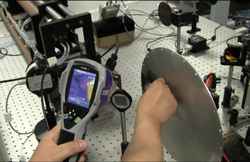
Posted to News on 30th May 2012, 15:35
Laser safety assured with FLIR compact camera
Safe use of lasers is generally assured by OEM design and health & safety protocols. But lasers in a research and development environment can present a greater danger both from a personal safety point of view and also as a fire risk.

In the interests of safety within their research environment, the University of Glasgow has invested in a FLIR i7 thermal imaging camera to protect researchers in its terahertz infrared laser laboratory.
The terahertz region of the electromagnetic spectrum is one of the least explored, but shows great potential for application in fields of science, security and medicine. The aim of this research project is therefore to develop a terahertz imaging system that can be used effectively across all these disciplines.
In line with the Class IV classification of the laser, university personnel wear safety goggles to protect their eyes. But eye safety is not the only consideration. If the infrared beam were to hit clothing or skin, it could cause serious damage despite its non-ionising characteristic.
Yong Ma, Research Assistant at the Microsystem Technology Group, in the School of Engineering at Glasgow University, explains: "I always scan the entire area with our FLIR i7 thermal imaging camera to detect any beams that are projected in the wrong direction."
Detecting infrared beams is not, however, the only application for this compact camera. It is also used to ensure wider safety in the laboratory by monitoring electrical equipment to detect any fault that may lead to overheating and fire. Gas valves, tubes and tanks are also subject to regular thermal inspection.
Yong Ma continues: "We use the FLIR i7 because it has a good balance of affordability and performance. And although its microbolometer detector is not especially designed to detect infrared radiation in the terahertz wavelength, it is ideal for detecting any increase in temperature that results from the beam hitting an object or surface."
Aligning optical equipment
In order to set the terahertz infrared laser beam on-target, Yong Ma uses a variety of infrared lenses and mirrors but the process can be challenging. Historically the laboratory used thermal paper to detect beam projection. This discolours when it becomes warm but it is a method that is far from being efficient.
Yong Ma concludes: "With the FLIR i7 the process is greatly improved. The camera allows me to detect the infrared beams efficiently, so set-up is now more reliable and accomplished much quicker."
The FLIR i7 is a top-of-the-range model in the FLIR entry-level series of thermal imaging cameras providing the user with relatively advanced features and performance. It features a 140 × 140 pixel array - providing an increased image quality of 36 per cent against its forerunner - and also a wider field of view. It is also much more robust, and is able to withstand a 2m drop test onto a hard surface without any detrimental effect.
To find out more about the FLIR i7 thermal imaging camera, visit the website at www.flir.com.






























